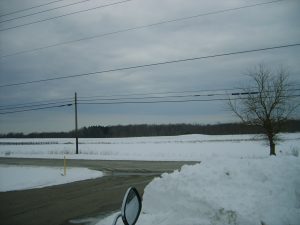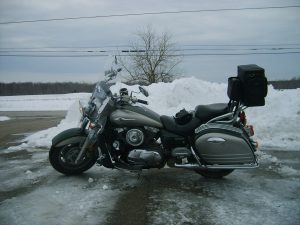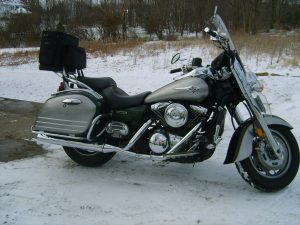


Part of this article is from On All Cylinders. And part from one of my old articles.
To start, let’s assume you’ll be wearing a full face helmet. Since you can lose a lot of heat through your head, a full face helmet is a key piece of winter riding apparel. You should regularly inspect your helmet anyway, but during the winter specifically check to make sure the headliner is intact and vents are free to open and close. For added peace of mind, companies make anti-fog spray that can reduce the chance of your faceshield fogging over.
Don’t just grab a big parka out of your closet; get a cold weather motorcycle jacket or heated jacket liner. Remember, baggy clothes won’t hold heat and the constant tug of the wind contributes to rider fatigue. A cold weather riding jacket should be snug and include extra thermal protection that can be zipped in and out when necessary. It’s also important that the jacket does not restrict your movement, so you’re able to maintain control of your motorcycle.
Based on riding position, your legs are often the most exposed parts of your body—ensure that they’re well protected with riding pants be that they are insulated leather or gore-tex riding pants. Make sure they fit well, but still allow you to put your leg down at stoplights and manipulate your foot controls. Companies make full or partial chaps also that guard your legs against the cold and can be easily removed, making them a good choice for the commuter.
As with the jacket and pants, winter gloves should fit perfectly. That allows them to retain heat, while still giving you free movement to work your clutch, brake, and various buttons and switches. Gauntlet-style gloves have skirts that overlap the sleeves of your jacket—further sealing out any cold air.
Winter riding boots play an important role, as your feet are often unprotected by a fairing. That leaves them exposed to road wind. Winter boots should overlap your pants, cutting down on exposed areas of skin. Make sure your boots have decent tread and can handle slippery environments. Water can puddle and freeze in the ruts created from semis resting at stoplights, making intersections treacherous.
Don’t forget about your neck. You can address this by wearing a turtleneck undershirt, or purchase a dedicated neck wrap. Avoid scarves—the last thing you want is a loose scarf end dangling around your rear sprocket! Socks are important too.
Water-soaked clothing holds little thermal protection, which is why winter riding gear should be water-resistant. Wool is a smart choice, because it can wick moisture away from the skin. Be aware of any built up sweat, too. Your gear needs to breathe and allow any sweat to dissipate through your clothing.
Dress in layers. Long underwear adds another level of warmth, while sweatshirts and jeans provide a good middle layer of protection. Always err on the side of dressing too warmly; you can always peel off a layer to cool down. All the years that I was a winter warrior I used heated gear from the jacket liner to the pants to the socks to the gloves. Best winter riding investment one can make if you are a true winter warrior. It’s just like riding on a toaster is what I tell everyone who see’s me out riding during the winter months.
Now that you’re dressed to grapple with a yeti, let’s look at your motorcycle. Without going into a full-blown inspection list here, remember to do regular checks of your chain/belt/shaft, tires, brakes, and suspension, to make sure your ride is roadworthy. Winter roads are obviously more daunting than summer roads. You’ll experience ice, road salt, and potholes—make sure your bike is physically ready for winter’s assault. And that you are physically ready to ride in the winter elements.
You can also modify your bike to make your ride more comfortable—specifically in the form of heated grips. Heated grips use your battery’s power to warm elements in (or under) the grips. You can also add heated seats. Make sure that your bike’s electrical system can handle the extra current draw and you have room to install the switches, wires, and relays necessary to make them work.
Depending on the style of motorcycle, the addition of a faring (or larger windshield if already equipped) is an obvious way to protect your body against constant icy wind blasts. As with any install, make sure that all of your levers, mirrors, and switches operate freely before venturing out on the roads. If you’re looking at a dedicated winter fairing, select one that offers maximum body coverage.
When you’re ready to take to the winter road, remember that there are several unique hazards posed to a motorcyclist in winter. Be wary of any new potholes that appear; snowplows love turning highways into obstacle courses. Always be on the lookout for excess road salt and sand—it tends to build up near intersections. Your fellow motorists are more of a danger than ever, as it’s uncommon to see a motorcycle in the roads in the dead of winter.
Depending on your location, ice represents the ultimate hazard to the winter rider. You do not want to hit a patch of that stuff. It might be a good idea to drive your route in a car first, scanning for any potential icy zones.
Be safe: ride alert, ride prepared, and ride confidently. Winter riding can be the most rewarding motorcycling you’ll ever experience. I personally really enjoyed riding during the winter months. Another key tip here is don’t ride at night time in the snow belt area’s during the winter. All the years when I was a winter warrior I did not ride at night time during the winter. Only rode during the daylight hours. Now for all you riders down south or out west just continue to ride in the winter in awesome riding weather. Keep the contact patch between the lines. Michael Theodore National Road Captain
The following two tabs change content below.


Michael Theodore is married to Laureen, and both are devoted followers of Jesus Christ. Michael serves the Azusa StreetRiders Motorcycle Ministry as both National Road Captain and as Ohio District Coordinator. He is passionate not only about riding, but also using motorcycles as a witnessing tool to affect souls for the Lord Jesus.
Latest posts by Michael Theodore (see all)
- Happy New Year 2024 - December 31, 2023
- Letter from the Pres. - December 31, 2023
- “17 INCHES” - December 30, 2023
